 Our summer visitors have gone, and our winter visitors have firmly settled in for the next few cold months. This time though, there are no traffic jams, no sat nav mistakes, and no refusals to reverse.
Our summer visitors have gone, and our winter visitors have firmly settled in for the next few cold months. This time though, there are no traffic jams, no sat nav mistakes, and no refusals to reverse.
These winter visitors come huge distances to escape from the colder climates of the far north. In Gerrans Bay there are Great Northern Divers from Greenland, Blackthroated Divers from northern Scotland and Scandinavia, Slavonian Grebes, mainly from Iceland, and Rednecked Grebes from southern Scandinavia and eastern Europe. Blacknecked Grebes from central Europe are here too, but they favour the waters of the Carrick Roads, especially off Messack, as also do the visiting Redbreasted Mergansers from Iceland. They also can be seen regularly on the Percuil river.
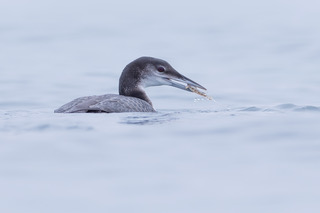 There are still pockets of a few breeding Slavonian and Blacknecked Grebes breeding in the wilder areas of northwest Scotland, together with the Redbreasted Mergansers, which also come here for the winter.
There are still pockets of a few breeding Slavonian and Blacknecked Grebes breeding in the wilder areas of northwest Scotland, together with the Redbreasted Mergansers, which also come here for the winter.
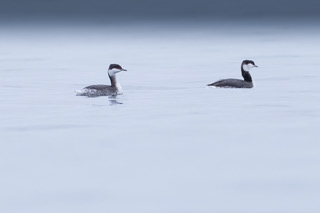 Then there are Common Scoter in rafts on the sea; while in the muddy estuaries are Wigeon from Siberia, Northwest Europe and Iceland. There are also huge numbers of Teal and Starlings arriving from Europe too, including Russia, to join our local birds for the winter. Our small resident Lapwing flocks increase threefold as so many pour in from the continent; and Golden Plover increase sixfold as they arrive from Iceland, Norway and Sweden.
Then there are Common Scoter in rafts on the sea; while in the muddy estuaries are Wigeon from Siberia, Northwest Europe and Iceland. There are also huge numbers of Teal and Starlings arriving from Europe too, including Russia, to join our local birds for the winter. Our small resident Lapwing flocks increase threefold as so many pour in from the continent; and Golden Plover increase sixfold as they arrive from Iceland, Norway and Sweden.
What I have given you here is just a flavour of the huge increase in visitors each winter. There are many more too. Continental Blackbirds, Thrushes and even robins swell our numbers here!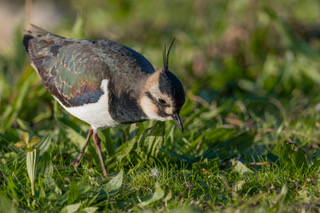
And not a Chelsea tractor in sight! Then from March through to May these birds depart to breed in places which are briefly hospitable for them for habitat and food. The tundra, the Artic Circle, Iceland, Siberia and the lonelier expanses of northern and eastern Europe are where they lay their eggs, raise their young; feed; and eventually repeat their route to the Roseland once again next winter.
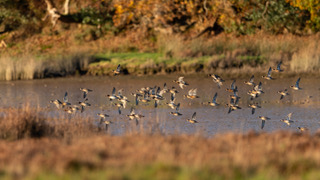
At our AGM all officers were re-elected until November 2022, with just one addition, that of Nicola Zaina who becomes secretary. Harry Davies, one of our Roseland National Trust rangers gave a presentation on butterflies which was absolutely fascinating. Harry’s theme was Butterflies: the survival of the fittest. Using a mixture of commentary, slide and film we learnt some amazing survival strategies.
 For example, some butterflies have a symbiotic relationship with ants and need them to protect and feed developing pupae. Others live their lives totally within a 50 metre radius, dependent on specific plants. Some only live as butterflies for a few days, and others for just a month.
For example, some butterflies have a symbiotic relationship with ants and need them to protect and feed developing pupae. Others live their lives totally within a 50 metre radius, dependent on specific plants. Some only live as butterflies for a few days, and others for just a month.
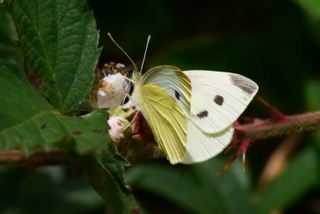 Migrating species depend for their journeys upon the wind direction several hundred metres above ground and assess that by making exploratory flights up from ground level to the height needed. If the wind is in the wrong direction, somehow they know, so come back down to their current home patch to try again later. Other butterflies have learnt how to recognise toxins when feeding by information analysed by their front legs, thus avoiding poisoning. It was a gem of a presentation!
Migrating species depend for their journeys upon the wind direction several hundred metres above ground and assess that by making exploratory flights up from ground level to the height needed. If the wind is in the wrong direction, somehow they know, so come back down to their current home patch to try again later. Other butterflies have learnt how to recognise toxins when feeding by information analysed by their front legs, thus avoiding poisoning. It was a gem of a presentation!
Harvest Mice on the Roseland
 I was recently asked by Dave Groves, Chair of the Cornwall Mammal Group, if we could find out whether there are any Harvest Mice nesting on the Roseland. They have only ever had 5 records from here, and only 21 submitted to ERCCIS from the whole of Cornwall in the last 5 years.
I was recently asked by Dave Groves, Chair of the Cornwall Mammal Group, if we could find out whether there are any Harvest Mice nesting on the Roseland. They have only ever had 5 records from here, and only 21 submitted to ERCCIS from the whole of Cornwall in the last 5 years.
The context for this is the launch of a nationwide survey of Harvest Mice, organised by the Mammal Society, (see their website,) using us as citizen scientists to gather records of abandoned Harvest Mice nests. Some training may be available.
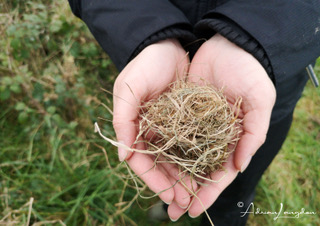 Already two of our group have told me of sites where a nest was found by each of them last summer. But what do you have to look for? It’s easy, especially at this time of year up to about March. Their distinctive nests are to be found typically in tall grasses, such as reed or sedges, marshes, rough grassland, brambles and field margins. Gardens, road verges and low hedges are also used.
Already two of our group have told me of sites where a nest was found by each of them last summer. But what do you have to look for? It’s easy, especially at this time of year up to about March. Their distinctive nests are to be found typically in tall grasses, such as reed or sedges, marshes, rough grassland, brambles and field margins. Gardens, road verges and low hedges are also used.
They have very small golf-balled sized day nest as well as tennis ball sized breeding nests, woven from strips of leaves and attached to plants from 10cm above ground level to 1 metre. It is not obvious that they have an entrance hole. The nests are abandoned in winter, as the Harvest Mice move down then to ground level.
Negative results are just as valuable as positives. For any site record the site name, its description, location, (grid reference preferably) and your contact details. Please photograph the nest in situ and surrounding vegetation.
Contact via Cornwall Wildlife Trust, 01872 273939, ext. 310.
or Email cornwallmammals@btinternet.com
Website www.cornwallmammalgroup .org
There is also a Devon Harvest Mouse project Facebook page which you should find helpful.
I do hope that some of you would like to take part.
Save the Date
Later this month our next presentation will take place. It is a return visit by Rupert Kirkwood, also known as The Lone Kayaker, full of photos, sounds and film taken from his kayak as he travels around our local bays and further afield. The title says it All at Sea – Watching Wildlife from a Kayak.Those of you who saw him 2 years ago when he gave his first presentation to us know it is a remarkable evening, not to be missed. This year it is in Gerrans Parish Memorial Hall at 7.00pm on Tuesday 25th January. Covid protocols will apply.
Thanks to you all for supporting Wild Roseland,
David Hall
Big Garden Birdwatch 28-30 January 2022
This annual survey is building up an important picture of what the population trends are for our garden birds. The top ten most common birds in the UK in 2021 were in order,
1 House Sparrow, 2 Blue Tit, 3 Starling, 4 Blackbird, 5 Wood Pigeon, 6 Robin, 7 Great Tit, 8 Goldfinch, 9 Magpie, 10 Long-tailed Tit. Our finches, in particular, greenfinches and chaffinches showed continuing decline.
Once again could I interest you in participating in this important RSPB survey of the state of Britain’s garden birds in winter?
Have a look at the RSPB website for full details. It explains how to participate, how to attract birds to your garden and how to recognise them. There is also a section which allows you to add other wildlife records of mammals, invertebrates, and amphibians too.
RSPB Big Garden Birdwatch
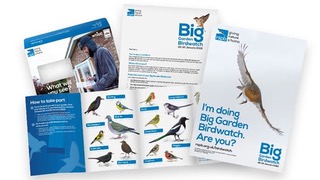
Acknowledgements
David Hall for the articles
Photos:
Lapwing flock, Jane Lewarne
Great Northern Diver, Stuart Martinez
Slavonian grebes, Stuart Martinez
Lapwing, Stuart Martinez
Teal flock, Stuart Martinez
Speckled Wood Butterfly, Jane Lewarne
Large White Butterfly, Jane Lewarne
Harvest Mouse, CMG
Harvest Mouse breeding nest, Adrian Langdon
